Saint Elizabeth (1207-1231) was a princess, the daughter of the king of Hungary. She lived in a castle on the top of a hill in the middle of Germany: she was married to the count of Thuringia. But after he died fighting in the Holy Land she was turned out of the castle and became a poor but holy woman in a plain, grey dress. She had never been so happy.
When she died the birds came and sang on the top of the church. People cut off pieces of her hair and graveclothes as holy relics. Many reported miracles done in her name after her death, especially at or near her tomb in Marburg.
Even when she was five she was religious. She would rather pray than play. She liked to pray laying face down on the ground with her arms stretched out. Even before she could read she would act as if she were reading the book of Psalms. Winning games made her uncomfortable and what she won she would give away.
She wanted to live as a poor virgin all her life, but her father, the king, wanted her to marry the count of Thuringia. She did so out of respect for him. She had sex and had children, but only as a duty not as a pleasure.
She would not eat the fine food that princesses ate in those days. She would push the food about on her plate or eat what the servants ate. When they were on the road that meant old black bread in hot water. When her husband was away she prayed all night.
She liked to pray the Our Father and Hail Mary. She liked the Te Deum.
With her own money she built a hospital to care for the sick. She sold her jewels to help feed the poor. She gave away clothing. She went to the funerals of the poor. Once she tore the linen veil from her face and used it to cover a poor, dead man before he was put into the ground. She was like Mother Theresa in our time, caring for the sick, the poor, the old and the dying.
After her husband died and she sank into poverty, her father, the king and her uncle, the bishop, offered to save her from her fate. But she said no: poverty is a virtue, the road to holiness. No one had ever seen anything like it: the daughter of the king living as a poor woman.
She prayed much and had visions of heaven. She once saw Jesus and, before she died, she saw her angel and the devil.
Many miracles were reported after her death when people visited her tomb or made a promise to God in her name. The dead were brought back to life (especially children pulled from rivers), the blind given sight and arms and legs made whole.
Feast day: November 17th.
See also:













